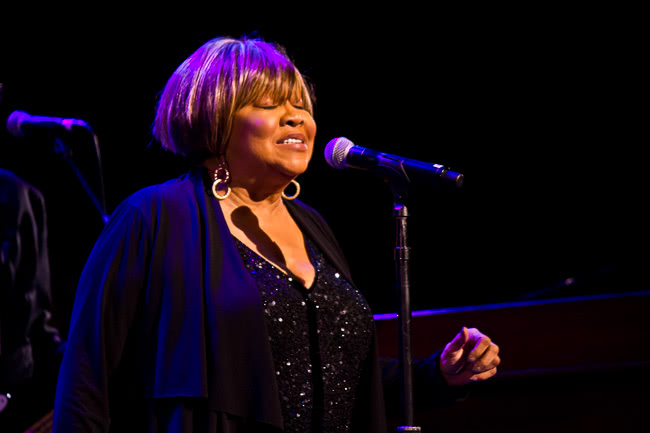Bonnie Raitt and band combine exquisite instrumental and vocal talents, honed over time into elegant tools for the production of fine, subtle and joyous rock music. Touring behind new recording Slipstream, which features a version of Gerry Rafferty’s “Right Down The Line”, the band are highly polished, but not to the point of predictability.
At Adelaide’s historic Thebarton Theatre, Raitt and her group of A-team players shared the bill with Mavis Staples and band. The historic gig attracted a mature audience, who perhaps attended to reengage with a particularly talented member of the ‘70s-‘80s rock elite, or delve further into the gospel and soul roots of the Staple Singers. Either way, they probably left with a sense of having experienced exactly what makes music really matter.
Mavis Staples’ band is essentially a four-piece vocal ensemble backed by a really hot three-piece R&B band. Led by guitarist Rick Holmstrom, a masterful and economical purveyor of classic Memphis style soul guitar, intuitive and economical backing is provided by drummer Stephen Hodges, bassist Jeff Turmes, and backup singers Donny Gerrard, Chavonne Morris and Yvonne Staples.
Following a stirring series of soul and gospel excursions, punctuated by highlights from the Staple Singers repertoire like “The Weight”, Mavis Staples left the stage and let her band engage in a fine set of R&B instrumentals. Staples then returned for a duet with Bonnie Raitt on “Will The Circle Be Unbroken”, before finishing up with a flourish of songs that demonstrated the band’s powerful combination of vocal harmonies and driving rhythms.
In a sense, Bonnie Raitt’s band represented a refinement of the elements that composed the Staples sound. A five-piece band, working as a tightly functioning unit, spiced up its sound and its impact with an added injection of well-oiled vocal harmonies.
The combination of James “Hutch” Hutchinson (bass), Ricky Fataar (drums), George Marinelli (guitar) and Mike Finnigan (keyboards) made certain that “Right Down The Line” was a standout early song, given an added zest by the brilliance of Raitt’s slide work, which was evident throughout the marvellous set.
“Let’s Give Them Something To Talk About” was another superbly crafted piece of vocal and instrumental synergy. Slide guitar effortlessly segued into ensemble playing and energetic harmonies and then back again, rousing an increasing degree of enthusiasm from the crowd. Next up Bob Dylan’s “Million Miles” turned into a blues lesson with a piano-vamping solo from Finnigan.
The reggae-tinged, bluesy feel of the self-penned “Come To Me” continued to display the song-driven elements of Raitt’s work. She decided to toss aside the song list and connect to her own feelings. The result was another great Raitt original with a heartfelt touch, “Love In The Knick Of Time”.
“Love Me Like A Man” gave the audience a chance to appreciate the acoustic and fingerpicking elements of Raitt’s style, imbibed in part from the work of Lowell George of Little Feat fame.
Raitt then emphasized her place in the remarkable chain of American musical performers from the last 50 years with a moving version of John Prine’s “Angel From Montgomery.” The strongly guitar and keyboard-driven “Love Letter”, followed this, tinged with a strong dose of slide guitar and punctuated by a driving drum flourish from veteran sideman Fataar.
Finnigan’s talents were given an outing with a Hammond and vocal turn on “I Got News For You”, as the band proved itself adept at turning on the Jimmie Smith sound by taking itself into R&B territory with a side serving of hot slide.
The last song for the night was “I Feel So Damn Good I’ll Be Glad When I Get The Blues”, a tour de force for the whole band. Shuffle style drums and strong walking bass moved the whole song along, provoking a happy and strong response from the audience, which rose to its feet to demonstrate satisfaction with a job well done
Thebarton Theatre was an apt setting for the essentially sit-down concert. Both Staples and Raitt showed their deep personal connection to their music as they introduced and highlighted the talents of their bands, passed on anecdotes and expressed their happiness with the gig.
Both bands have toured together for some time and both are worthy of attention for anybody with the desire to see how this kind of music endures and even prospers. The legacy of these two performers speaks volumes, something especially evident in the noticeably larger than usual contingent of female concert-goers at the gig.




































